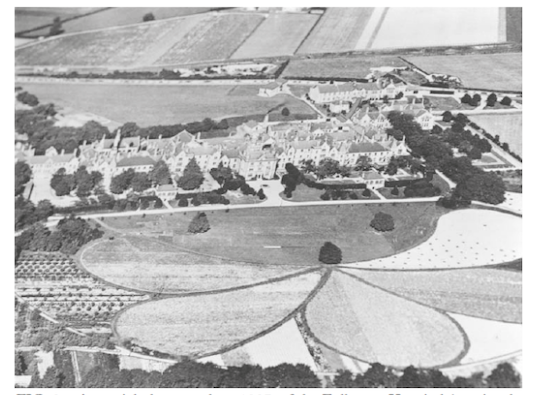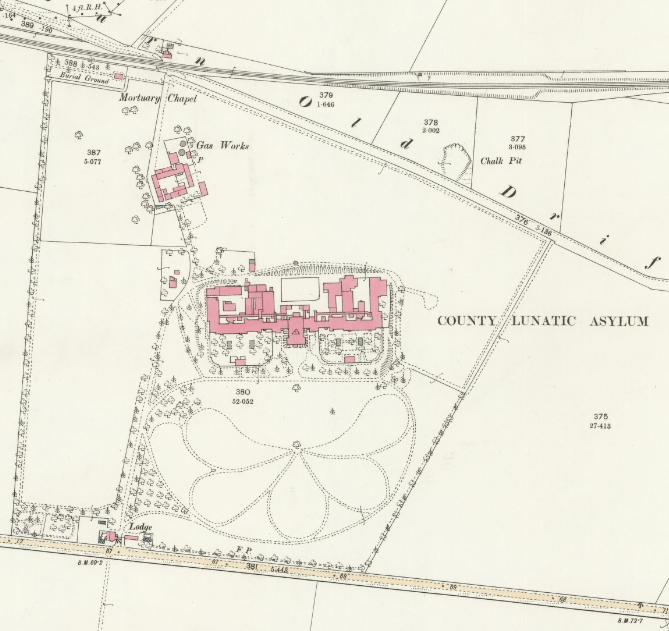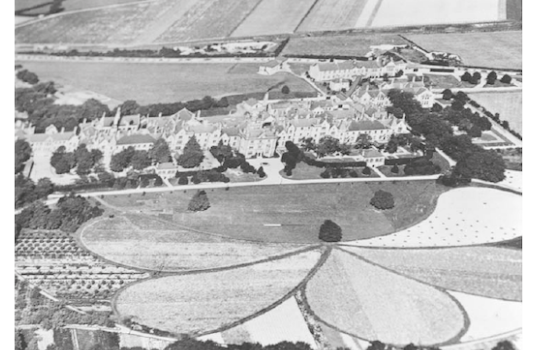Three interesting items about this prominent Cambridge landmark have come the way of Capturing Cambridge in the last few months.
It was in 1845 that local authorities in England were compelled in law to provide homes for the mentally ill. So in 1848 work commenced on the County Pauper Lunatic Asylum for Cambridgeshire at Fulbourn and it was opened ten years later. It became a significant employer for those in the south of the city.
One curious feature of the exterior design was the huge petal shaped beds that were established in front of the buildings. Research has shown that the parkland of interlocking pathways was intended to give patients access to a more natural and agricultural landscape. Ordnance survey maps show these patterns from as early as 1885 and they are visible in a photo from 1927.


The campaign in 2022 of Joanna Hudson to fund a Blue Plaque to commemorate the death at the asylum of chimney sweep’s climbing boy, George Brewster, in 1875, has shed light on the murky world of child exploitation. There was already legislation to prevent children sweeping chimneys passed in 1864, but this, as in the case of George Brewster, was not enforced nor even respected by the sweeping profession.
The press accounts of the case differ as to the facts of whether the boy was pulled out by the sweep, or whether the chimney was demolished to get the poor boy out, and even as to when the boy actually died and how old he was. It is interesting that the police actually went to the boy’s home in London to corroborate George’s age, only to find he was in fact only 11, rather than the 14 or 15 widely quoted.
Perhaps the most shocking observation is the complicity of all those who witnessed the sweep William Wyer turn up at the asylum with a boy who, having fed ravenously, was then pushed up a flue only 12 by 6 inches, even then an illegal size under the building regulations of the day.
The third story about the asylum is more romantic, though tinged with tragedy. An impoverished Anglo-Indian doctor by the name of William Arthur McCutchan was appointed Senior Assistant Medical Officer at Fulbourn asylum circa 1900. He had previously worked in Burghill Mental Asylum outside Hereford. It was here he met Florence Chave and fell in love. Florence was the daughter of a well-to-do businessman and her secret engagement to a poor doctor was not a wonderful prospect for her family.
The story of William and Florence has been recreated by Angela Hodges in her novel “You and You Only” (2022) which draws not only on records about the Fulbourn asylum but also on Florence Chave’s diaries, part of which Angela has also published.
William, ‘Mac’, to his friends, was a very popular figure, kind to patients and staff, keen on arranging musical entertainments at the asylum, and also on photography. However, in 1905 there was an outbreak of typhoid at the asylum. The Medical Superintendent fell ill and ‘Mac’ was left with the responsibility of running the whole establishment. He was much praised on how he handled the crisis but by the following winter his health had collapsed. He died at the Nursing Hostel in Thompson’s Lane in June 1906, aged 46. All his worldly possessions including almost 1,000 glass plate negatives were left to his secret fiancee Florence.
Florence never married. On her death two workmen clearing her attic found a tin of letters with instructions to burn them on her death, which they did on a bonfire.
Further reading:
If you have stories you would like to share on CapturingCambridge.org Cambridge please contact us using the email link on the site.
